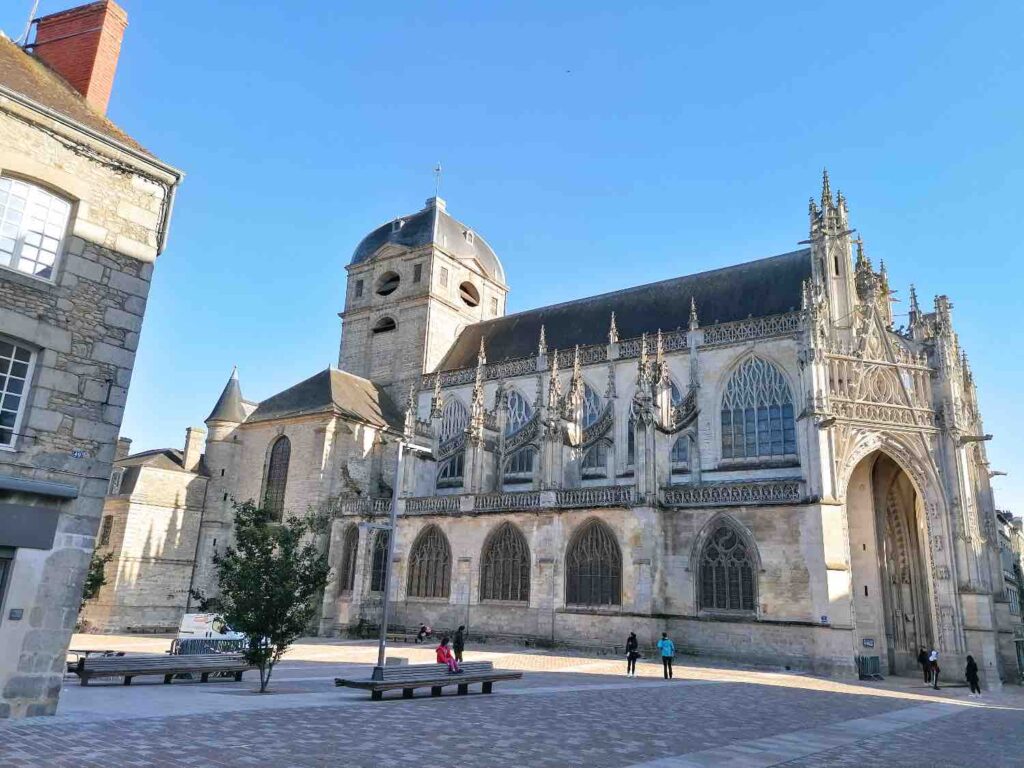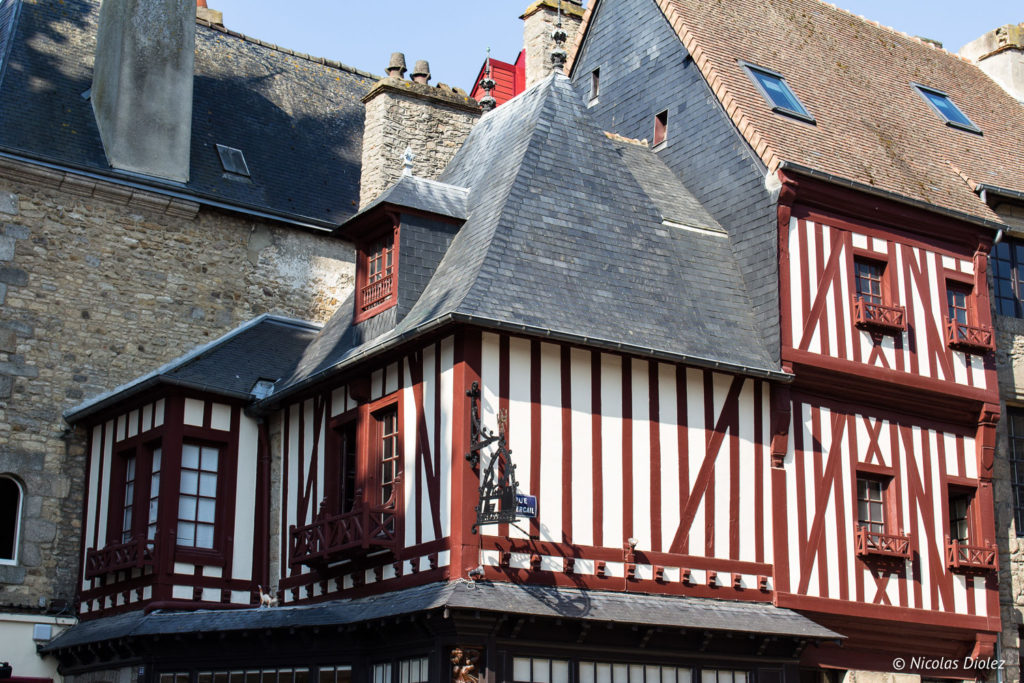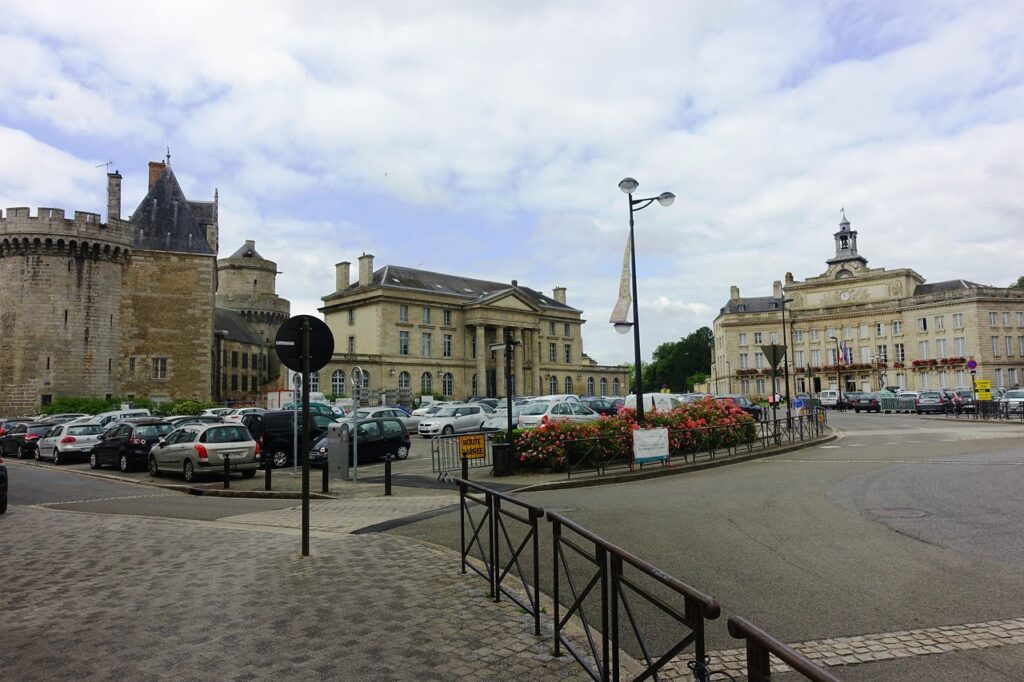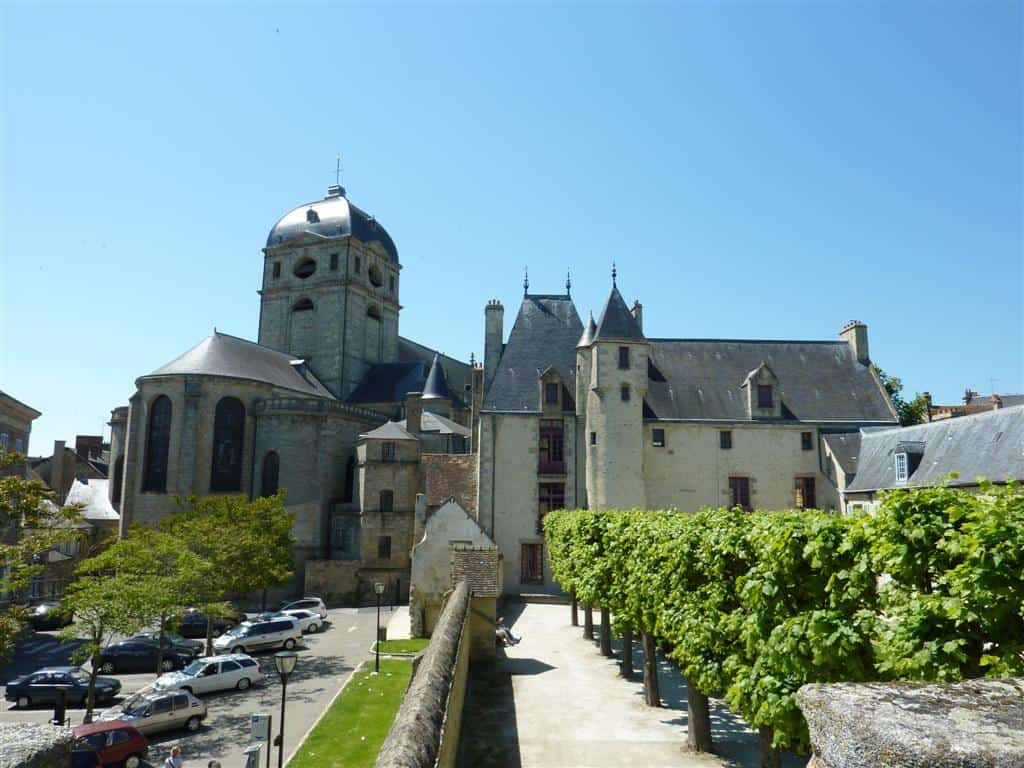The town is often described as the “queen of lace”, and the trade here has won UNESCO recognition as “intangible cultural heritage”.
Alençon is a French commune , prefecture of the Orne department , located in the Normandy region . Alençon is illustrated in green or cultural tourism , especially since the city is located between the Normandy-Maine regional natural park and the Perche regional natural park . It also plays its role of administrative, economic and commercial place in the departmental framework.
Sights
Places and monuments
Civil architecture
The castle of the Dukes.The Firefly.The house of Ozé .The wheat market.Front of the house in the Étal.Corner Grande Rue / Rue des Granges, in the heart of the old center of Alençon .
- The castle of the Dukes : built under Pierre II , Duke of Alençon between 1361 and 1404, partially dismantled under Henri IV , serving as a begging depot from 1768 to 1824, the existing buildings only represent 10% of the whole. There remains the châtelet, a curtain , the crowned tower and a postern ; the courthouse dating from the First Empire is next door. The Château des Ducs became a remand center where during the Second World War many people were tortured by the Gestapo .
- The town hall (place Foch): built in the shape of a circular arc from 1783 to 1788 by the architect Delarue. Originally, the town hall only occupied the central part. It was not until the xix th century, the town of Alençon marched purchaser the right and left parts that were privately owned. Before the end of the xx th century, the town occupied only 60% of the total area. In 1966, during the renovation of the mayor’s office, one found in the ceiling 297 posters of Charles Éléonor Dufriche-Valazé from 1793, deputy for Orne in 1792 and who committed suicide in 1793.
- The House Ozé ( xiv th century): Alderman Jean Mesnil made the change in 1450 . Charles de Valois, Duke of Alençon and his wife, Marguerite de Navarre lived there and would have even invited the future Henri IV THERE in 1576 . Threatened with destruction in 1899, it was classified as a historical monument in 1903 and restored. It now houses the tourist office. At its feet is the conservatory orchard of the Maison d’Ozé which is not strictly speaking a public gardenbecause if it can be a place of walk, it is rather a place of learning and experimentation on plants and other plants.
- Halle aux Blés : this circular building, built from 1811 to 1819 , was supplemented in 1865 with a glass dome designed by the local architect Charles Arnoul and the engineer Charles Croquefer. Originally devoted to the grain trade, this place is used today for various exhibitions and events.
- The Pesche pharmacy , at 4 place aux Blés, building Inscribed MH ( 1987 ) . The dispensary was created under the Directory in a building that had belonged to a linen merchant, a then prosperous industry. Inside, the fully painted ceiling recalls, with its palm trees, snakes, amphorae, beehive and bees and the trompe-l’oeil of a military tent that its first owner was a pharmacist in the armies returning from the Egyptian campaign. In addition to two monumental Italian ceramic vases in the display cases, the dispensary has a fine collection of Empire jars .
- The Aveline block (between rue du Collège and rue Julien) brings together buildings set up from 1675. This site first housed the Jesuit college, then the Central School of Orne, then a College and high school in 1848 (called Alain in 1956) to transfer it in 1963 in new buildings boulevard Mézeray and secondary school Aveline from 1963 to 1975. the buildings of the xvii th century were then restored and renovated to bring together the city’s cultural activities: Museum of Fine Arts and Lace, media library and library, lace workshop, municipal archives, conservatory, auditorium.
- The commercial court : with its polygonal tower, this elegant building of the middle of the xvi th century described by Balzac in Le Cabinet des Antiques was the finance office of the seat from 1640.
- The Orne Prefecture Hotel was originally a private mansion built around 1630 by a pruning collector in the election of Alençon, Charles de Fromont de Bouaille, Lord of Besnardière . In 1676 , Élisabeth d’Orléans , half-sister of the “ Grande Demoiselle ”, and cousin of Louis XIV , Duchess of Guise and appanagist of the Duchy of Alençon, took possession of it. Since 1815, this building has become the prefecture of Orne. Located behind, were erected gardens on more than three hectares contributing to the beautification of the whole. They are open to the public duringHeritage days .
- The Saint-Léonard district or Marais district: district of old Alençon with evocative names (rue du Château, rue Bonette, rue des Lombards, rue de la Juiverie) whose origins date back to the Middle Ages. The rue de la Juiverie, where a synagogue once stood, was inhabited in particular by prostitutes. This district in the early xx th century after Albert Lemaitre, president of the municipal association, was supposed to be “dirty, humid, unhealthy and smelly” .
- Place à l’Avoine was once a horse and oat market. At this place was the door Lancrel, one of the entrances of the city in the xviii th century.
- The old begging depot , founded by the intendant Jullien in 1774 and completed in 1782, accommodated the destitute, the insane, vagabonds and “daughters without morals”. It was managed by nuns until 1971. This place specialized in the twentieth century in a psychiatric hospital. Its buildings xviii th century house psychotherapeutic center of the Orne
- The house in Stall , located street door of the bar (one of the five entrances to the city in xv th century) is one of the oldest mansions of Alençon. It was partly demolished in 1776 but has retained its corbelled facade surmounted by a canopy, and the long stall of a single block of granite to which it owes its name.
- The Etaux crossroads – with the Place de la Magdeleine, the crossroads of the rue aux Sieurs, the Grande Rue and the rue de la Poterne – is one of the main crossroads in Alençon, located in the Saint-Léonard , undoubtedly the oldest in Alençon. In this district is the café des Sept Colonnes, one of the oldest houses in Alençon, and was once the Saint-Léonard cemetery until 1760.
- The Grande Rue is a main artery in Alençon which starts from this district and ends at the crossroads of rue Saint-Blaise, where the prefecture is located, rue Cazault and cours Clemenceau. It passes through the Place de la Magdeleine whose name comes from Marie de Magdala , saint who attended the burial and resurrection of Christ. Until 1789 there was a cemetery there. Today, this square serves as a connection to the Alto bus lines and a market is held there on Thursdays and Saturdays. This square has become over time one of the main ones in Alençon. This district is entirely pedestrian except for the buses.
- The rue aux Sieurs is with the Grande Rue the main shopping street in Alençon and is completely pedestrianized.
- The district of Montsort , once a simple suburb, owes its name to the swamps of the Sarthe river near the district (etymologically “Mont au sec”). He saw arriving in the morning ofAugust 12, 1944the tanks of the 2 nd Armored division enter Alençon, by the current rue du Mans. It is in this district that Marshal Leclerc installed his headquarters. The association “Commune libre de Montsort” was founded there in 1957, on the model of the Republic of Montmartre in Paris , of which solidarity is the common thread.
Religious buildings
- The Basilica of Our Lady of Alençon, rue Étoupée : nave of the xv th century, flamboyant porch early xvi th century. Following a fire, the choir and the bell tower was rebuilt in the middle of the xviii th century . The Notre-Dame d’Alençon church was elevated to the rank of basilica onJune 6, 2009by Benedict XVI by a decree of the Congregation for Divine Worship and the Discipline of the Sacraments . The tribune organ is from 1535.
- The St. Leonard church, rue Saint-Léonard, flamboyant Gothic style of the turn of the xv th and xvi th centuries, tower of St Martin xii th century, much altered in the xvii th century following the collapse the nave vaults and restored outrageously the xix th century.
- Saint-Pierre church in the Montsort district , place de la 2 e Division Blindée.
- Saint-Roch Church , rue de l’Église.
- Sainte-Thérèse Church, avenue Winston Churchill, built at the end of the 1960s in the Perseigne district.
- Christ Roi Church, avenue de Courteille.
- Notre-Dame-de-Lorette chapel , rue du Mans : built around 1680 in the district of Montsort .
- The Sainte-Thérèse chapel , rue Saint-Blaise, birthplace of Saint Thérèse , house of Saints Louis and Zélie Martin : the pilgrimage has intensified since 2008 on the occasion of the beatification of the parents of Saint Thérèse.
- The Saint-Joseph chapel of the former Jesuit college , rue du Collège .
- The chapel (house of associations), rue Étoupée.
- The chapel (retirement home), rue Alfred De Musset.
- The chapel of the Hôtel-Dieu, rue de Sarthe.
- The Saint-Joseph chapel, rue de l’Abreuvoir.
- The Saint-Antoine chapel (psychotherapy center), rue Julien .
- The convent chapel of the Clarisses, rue Demi-Lune .
Parks and gardens
The Parc des Promenades (more than 4 ha ) is the Alençonnais’ favorite place to walk. Built in 1783 , renovated in 1999 , located near the town hall and the courthouse, it offers a bandstand , a pool, play areas for children and animal enclosures. It also offers a bowling green as well as a refreshment stall. It is not uncommon in the spring to see high school and college students revising their homework on the wide lawns offered by the Parc des Promenades, which is closed at night. Various activities take place regularly in this park .
The Gustave-Courbet park ( 2 ha ), located in front of the Alençon hospital, offers a vast place to walk along the Sarthe , as well as play areas with a swing and a slide for children. It also allows you to reach, passing under avenue de Koutiala, the arboretum of Alençon and the town of Saint-Germain-du-Corbéis .
The Koutiala arboretum ( 5 ha ), located on the edge of Saint-Germain-du-Corbéis, on avenue de Koutiala offers a place for picnics and walks over 4 hectares and you can admire more than 70 different varieties. of trees and more than 40 oaks .
The urban park of Perseigne ( 5 ha ) or small wood offers a place of walk and relaxation for the inhabitants of Perseigne. This park is currently under renovation. A little further on, at the edge of the Sarthe department , are the allotment gardens .
The Pyramid Park also called fairground (Place Charles-de-Gaulle), wedged between Avenue de Basingstoke (formerly Route de Sées ) and Avenue de Quakenbrück (formerly Route de Paris), offers an important space for play boules as well as games for children.
The park of Cerisé, rue d’Argentan, in the Lancrel district, offers a place of rest.
The town is a town in bloom (three flowers) in the competition of towns and villages in bloom.
Industrial heritage
The files of the industrial heritage of the Orne for Alençon: two flour mills on the Sarthe, hosiery factories, dyeing , ceramics, a tannery, three printing works , the Prout-France Confort sawmill and a woodworking factory .
Museums
The Museum of Fine Arts and Lace of Alençon, adjacent to the library, dedicated, in addition to the lace, the French schools of painting, Italian and Nordic of the iv th to the beginning of xx th century and the arts Cambodia . Temporary exhibitions, in particular on famous couturiers, are organized there regularly.
The birthplace of Saint Thérèse, located 50 rue Saint-Blaise, was reopened on May 9, 2009after major accessibility and scenography work. It has a reception hall, a gallery exhibiting personal belongings of the Martin family, an auditorium with a film presentation, and the various furnished rooms of the house: living room, bedrooms, kitchen.
The piano museum , at 9, rue de l’École-Normale , has been open since summer 2014.
Médiathèque and libraries
The city of Alençon has delegated its Public Reading competence to the urban community of Alençon (CUA). Geographically, four establishments are located in the municipality, but they are part of a network which includes ten media libraries and libraries throughout the AUC territory. A single card for the ten establishments allows documents to be borrowed and returned in either library.
- The Aveline media library is the central media library. It offers collections on all media, book, audio, video, press. It offers a space for work and study. Internet is available free of charge via Wi-Fi.
- The Perseigne media library offers a digital space, a jukebox and a video game room equipped with an Xbox with Kinect.
- The Courteille library notably has a DVD collection for the general public.
- The Four Seasons library is located in a home for the elderly.
Cinemas, theaters, contemporary arts and entertainment
La Luciole is the current structuring music scene of production and distribution. It was recently renovated and is part of the restructuring of the western area of Alençon.
The Planet’Ciné cinema offers films every week in its seven theaters. The old cinema, Les 4 Normandy, has been converted into a location for a temporary store.
Les Bains-Douches , a place of contemporary art located in the Courteille district, is a place of dissemination and production established since 2011 in the former baths-showers of the city of Alençon built in 1931.
The Scène nationale 61 is a French theatrical structure, located in the department of Orne. Since 2004, it brings together the Alençon theater, that of Flers, and that of Mortagne-au-Perche.








